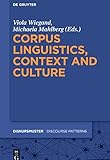Corpus Linguistics, Context and Culture / ed. by Viola Wiegand, Michaela Mahlberg.
Material type: TextSeries: Diskursmuster / Discourse Patterns ; 15Publisher: Berlin ; Boston : De Gruyter, [2019]Copyright date: ©2020Description: 1 online resource (VII, 492 p.)Content type:
TextSeries: Diskursmuster / Discourse Patterns ; 15Publisher: Berlin ; Boston : De Gruyter, [2019]Copyright date: ©2020Description: 1 online resource (VII, 492 p.)Content type: - 9783110486728
- 9783110487114
- 9783110489071
- online - DeGruyter
- Issued also in print.
| Item type | Current library | Call number | URL | Status | Notes | Barcode | |
|---|---|---|---|---|---|---|---|
 eBook
eBook
|
Biblioteca "Angelicum" Pont. Univ. S.Tommaso d'Aquino Nuvola online | online - DeGruyter (Browse shelf(Opens below)) | Online access | Not for loan (Accesso limitato) | Accesso per gli utenti autorizzati / Access for authorized users | (dgr)9783110489071 |
Frontmatter -- Contents -- Introduction -- Part I: Discourse contexts and cultures -- Patterns of discursive urban place-making in Brooklyn, New York -- The English of current Caribbean newspapers -- Corporate identity and its variation over time -- Applying Geographical Information Systems to researching historical corpora -- Corpus linguistics: Widening the remit -- Part II: Contexts of lexis and grammar -- Family collocation -- Factors influencing the translation of -ing participial free adjuncts -- The diachronic productivity of native combining forms in American English -- Advise against -ing: An emerging class of exceptions to Bach’s Generalization -- Subjective progressives in the history of American English -- Part III: Learner contexts -- A syntactic analysis of the introductory it pattern in non-native-speaker and nativespeaker student writing -- Phraseological teddy bears -- “Dear Man men and women madam, dear xxx sir” -- Marked themes in advanced learner English -- Phrasal verbs in the spoken and written modes of Norwegian L2 learner English -- Conversational gesture corpus analysis -- Corpus research for SLA -- List of contributors -- Index
restricted access online access with authorization star
http://purl.org/coar/access_right/c_16ec
Corpus Linguistics, Context and Culture demonstrates the potential of corpus linguistic methods for investigating language patterns across a range of contexts. Organised in three sections, the chapters range from detailed case studies on lexico-grammatical patterns to fundamental discussions of meaning as part of the ‘discourse, contexts and cultures’ theme. The final part on ‘learner contexts’ specifically emphasises the need for mixed-method approaches and the consideration of pedagogical implications for real world contexts. Beyond its contribution to current debates in the field, this edited volume indicates new directions in cross-disciplinary work.
Issued also in print.
Mode of access: Internet via World Wide Web.
In English.
Description based on online resource; title from PDF title page (publisher's Web site, viewed 25. Jun 2024)


